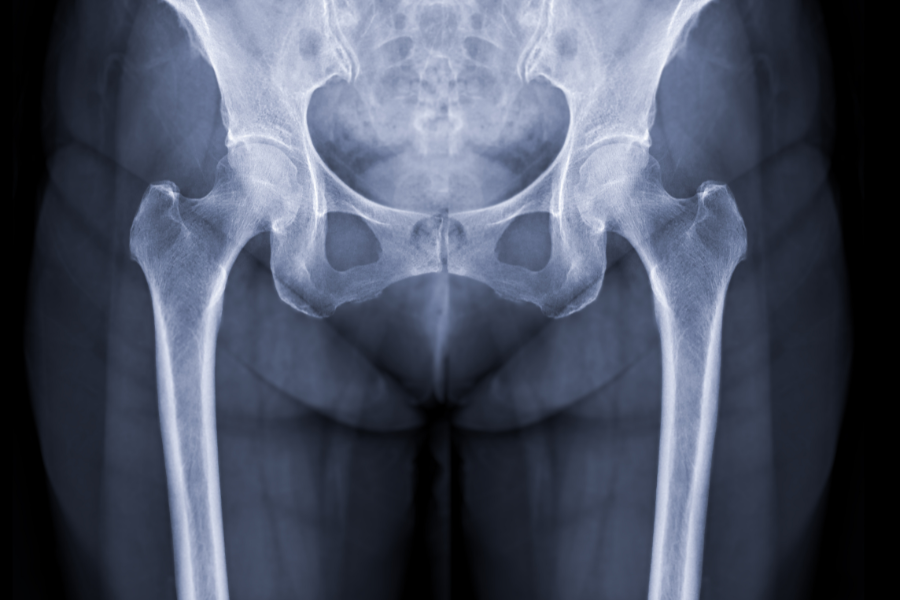 What is a Hip Fracture?
What is a Hip Fracture?- What are the Symptoms of a Hip Fracture?
- How is a Hip fracture Diagnosed?
- How are Hip Fractures Treated?
- How to Prevent Hip Fractures
Did you know that hip fractures are more prevalent than you might think? More than 300,000 people in the United States experience hip fractures every year. Our bones naturally weaken as we age, making us more vulnerable to fractures, particularly in the hip area. That’s why it’s important to protect your hip and take precautions if you are prone to injuries.
At the Louisville Hip & Knee Institute, we provide our patients with comprehensive information about common conditions related to hip and knee injuries. Understanding the causes of hip fractures helps with prevention, but this guide also includes what happens in a hip fracture and what kind of treatment to expect.
What is a Hip Fracture?
A hip fracture happens when the upper part of the thighbone, called the femur, breaks. A fall or a car accident is frequently to blame for this injury. Older individuals are particularly susceptible to hip fractures because aging can weaken bones over time.
Hip fractures are typically very painful, which means that surgical intervention is often necessary to address the injury quickly. A complete hip replacement may sometimes be required after a fracture. Physical therapy is often recommended to help those with hip fractures improve their recovery prospects after surgery.
Several factors can increase one’s risk of developing a hip fracture. Age is a primary determinant, with individuals over 65 facing an increased susceptibility due to weakened bones and balance issues. Gender differences are also notable, with nearly 75% of cases occurring in older women due to menopause-related bone loss. A sedentary lifestyle, excessive alcohol consumption, certain medications, osteoporosis, and overall health status can further increase the risk of hip fractures.
What Part of the Hip Can Break?
The curved hip socket (acetabulum) of the hipbone (pelvis) and the upper portion of the thighbone (femur) make up the hip joint, which is a ball-and-socket structure. The femoral head, also known as the “ball,” sits snugly in the hip socket, creating the joint. Muscles, tendons, ligaments, and soft tissues support this complex structure.
Hip fractures can occur in various areas of the upper femur, with the most common types being:
- Femoral neck fracture involves the area of bone just below the femoral head, known as the neck.
- An intertrochanteric fracture occurs in the area between the femoral neck and the long, straight part of the femur.
What are the Symptoms of a Hip Fracture?
Symptoms of a hip fracture often manifest suddenly, although they can also develop gradually and worsen over time. Common signs of a hip fracture include:
- Pain: Hip pain associated with a fracture is typically severe and sharp, but it can also be mild or achy. Pain is commonly experienced in the thigh, outer hip, pelvis, and groin area, and it may radiate down to the leg (sciatica) or even cause knee pain.
- Limited mobility: Individuals with a hip fracture typically experience difficulty standing or walking. In some cases, walking may be possible, but putting weight on the affected leg is often extremely painful.
- Physical changes: Observable changes may include bruising on the hip, asymmetry in leg length (one leg appearing shorter than the other), or an apparent misalignment, twist, or rotation of the hip joint.
What Causes a Hip Fracture?
Hip fractures commonly occur due to accidents, such as falls or car crashes. Additionally, athletes, particularly long-distance runners, may develop stress fractures in the hip from repetitive use.
Hip fractures can arise from seemingly minor falls or sudden twisting movements in older individuals. Moreover, individuals with osteoporosis are at risk of hip fractures during routine activities like walking or rising from a chair.
How is a Hip Fracture Diagnosed?
 During your medical assessment, your healthcare provider will thoroughly examine the affected region and inquire about any recent accidents or falls. To assess for neuropathy, a nerve damage condition, your provider may gently touch your foot or leg and ask if you experience any sensation.
During your medical assessment, your healthcare provider will thoroughly examine the affected region and inquire about any recent accidents or falls. To assess for neuropathy, a nerve damage condition, your provider may gently touch your foot or leg and ask if you experience any sensation.
To diagnose a fracture and evaluate potential soft tissue damage, your provider may recommend imaging studies, including:
- X-ray: This imaging technique utilizes radiation to generate detailed images of your bones.
- MRI (Magnetic Resonance Imaging): This diagnostic test employs a powerful magnet to produce images of bones and soft tissues.
- CT scan (Computed Tomography): Using computer technology and multiple X-rays, this test allows your provider to obtain highly detailed images of the affected area.
How are Hip Fractures Treated?
The treatment plan for a hip fracture depends on several factors, including your age, overall health, and the type of injury. For most hip fractures, surgery is required within one or two days after the injury. However, in some cases, surgery may not be a viable option due to pre-existing health conditions or age.
Your healthcare provider will tailor a treatment plan specific to your needs, which may encompass the following:
 Surgery: Surgery is typically necessary to repair hip fractures, and various techniques may be used to stabilize and align the bones, such as metal screws, nails, or plates.
Surgery: Surgery is typically necessary to repair hip fractures, and various techniques may be used to stabilize and align the bones, such as metal screws, nails, or plates.- Hip replacement: A partial or total hip replacement may be required depending on the severity and type of injury. Following hip replacement surgery, your provider may recommend a period of rehabilitation in a specialized facility to aid in your recovery.
- Physical therapy (PT): Your physical therapist will design a tailored physical therapy program to help restore movement, flexibility, and strength to the affected hip. For individuals who have undergone hip replacement surgery, performing specific exercises to enhance range of motion can significantly aid recovery.
- Medications: Both over-the-counter and prescription pain medications may be prescribed to manage pain and reduce inflammation. Individuals who undergo surgery for hip fractures may also receive antibiotics to lower the risk of infection.
How to Prevent Hip Fractures
It is important to take preemptive measures to avoid hip fractures to maintain good health and wellness, particularly as we age. It is essential to adopt a healthy lifestyle and implement preventive measures. Here are some strategies that can help to decrease the chances of experiencing hip fractures:
 Nutrition: Adequate calcium and vitamin D intake is crucial for bone health. Aim for 1,200 milligrams of calcium and 600 international units of vitamin D daily, especially for individuals aged 50 and older.
Nutrition: Adequate calcium and vitamin D intake is crucial for bone health. Aim for 1,200 milligrams of calcium and 600 international units of vitamin D daily, especially for individuals aged 50 and older.- Exercise: Engage in regular weight-bearing exercises to strengthen bones and improve balance. Walking, dancing, and strength training can help maintain peak bone density and reduce the risk of falling. Incorporating balance exercises into your routine is also essential, as balance tends to deteriorate with age.
- Lifestyle Habits: Avoid smoking and excessive alcohol consumption, as they can weaken bones and impair balance, increasing the risk of falls. Additionally, assess your home for hazards such as throw rugs, loose cords, and cluttered pathways. Ensure adequate lighting in all rooms and passageways to prevent tripping accidents.
- Regular Health Check-ups: Schedule regular eye exams every other year or more frequently if you have diabetes or an eye disease. Good vision is essential for navigating your surroundings safely and preventing falls. If you experience difficulty walking or feel unsteady, consider using assistive devices such as canes, sticks, or walkers.
By incorporating these preventive strategies into your lifestyle, you can significantly reduce the risk of hip fractures and maintain optimal bone health as you age.
Proper awareness and proactive measures can prevent hip fractures, but you should always have an orthopaedic surgeon check your hip if you feel pain and discomfort.
If you or a loved one is experiencing symptoms of a hip fracture or would like to learn more about prevention strategies, don’t hesitate to schedule an appointment at the Louisville Hip & Knee Institute. Our team of experts is dedicated to providing comprehensive care and treatment options to help you regain mobility and improve your quality of life.

